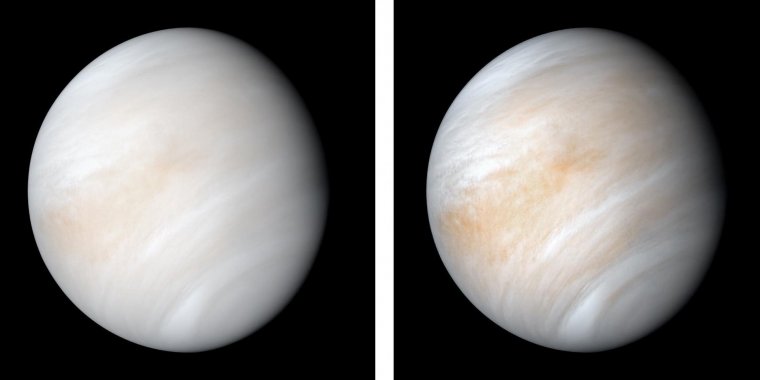| News / Science News |
Could acid-neutralising life-forms make habitable pockets in Venus’ clouds?
It’s hard to imagine a more inhospitable world than our closest planetary neighbour. With an atmosphere thick with carbon dioxide, and a surface hot enough to melt lead, Venus is a scorched and suffocating wasteland where life as we know it could not survive. The planet’s clouds are similarly hostile, blanketing the planet in droplets of sulphuric acid caustic enough to burn a hole through human skin.

Venus from Mariner 10. Photo: NASA/JPL-Caltech
And yet, a new study supports the long-held theory that, if life exists, it might make a home in Venus’ clouds.
The study’s authors, from MIT, Cardiff University, and the University of Cambridge, have identified a chemical pathway by which life could neutralise Venus’ acidic environment, creating a self-sustaining, habitable pocket in the clouds.
Within Venus’ atmosphere, scientists have long observed puzzling anomalies — chemical signatures that are hard to explain, such as small concentrations of oxygen and nonspherical particles unlike sulphuric acid’s round droplets.
Perhaps most puzzling is the presence of ammonia, a gas that was tentatively detected in the 1970s, and that by all accounts should not be produced through any chemical process known on Venus.
In their new study, the researchers modelled a set of chemical processes to show that if ammonia is indeed present, the gas would set off a cascade of chemical reactions that not only neutralises surrounding droplets of sulphuric acid, but also would explain most of the anomalies observed in Venus’ clouds.
As for the source of ammonia itself, the authors propose the most plausible explanation is of biological origin, rather than an non-biological source such as lightning or volcanic eruptions.
The chemistry suggests that life could be making its own environment on Venus.
“No life that we know of could survive in the Venus droplets,” said study co-author Sara Seager, from MIT. “But the point is, maybe some life is there, and is modifying its environment so that it is livable.”
‘Life on Venus’ was a trending phrase last year, when scientists including Seager and her co-authors reported the detection of phosphine in the planet’s clouds.
On Earth, phosphine is a gas that is produced mainly through biological interactions. The discovery of phosphine on Venus leaves room for the possibility of life. Since then, however, the discovery has been widely contested.
Inspired to look more closely, co-author Dr Paul Rimmer from Cambridge’s Department of Earth Sciences began combing through data from past missions to Venus.
In these data, he identified anomalies, or chemical signatures, in the clouds that had gone unexplained for decades. In addition to the presence of oxygen and nonspherical particles, anomalies included unexpected levels of water vapor and sulphur dioxide.
Rimmer proposed the anomalies might be explained by dust. He argued that minerals, swept up from Venus’ surface and into the clouds, could interact with sulphuric acid to produce some, but not all of the observed anomalies.
He showed the chemistry checked out. But the physical requirements were unfeasible: A massive amount of dust would have to loft into the clouds to produce the observed anomalies.
“The hypothesis requires either large amounts of water-rich volcanism or transport of a lot of dust rich in hydroxide salts,” he said. “So far, I have been unable to identify a plausible mineralogy for this mechanism.”
The researchers wondered if the anomalies could be explained by ammonia. In the 1970s, the gas was tentatively detected in the planet’s clouds by the Venera 8 and Pioneer Venus probes. The presence of ammonia, or NH3, was an unsolved mystery.
“Ammonia shouldn’t be on Venus,” said Seager. “It has hydrogen attached to it, and there’s very little hydrogen around. Any gas that doesn’t belong in the context of its environment is automatically suspicious for being made by life.”
If the team were to assume that life was the source of ammonia, could this explain the other anomalies in Venus’ clouds? The researchers modeled a series of chemical processes in search of an answer.
They found that if life were producing ammonia in the most efficient way possible, the associated chemical reactions would naturally yield oxygen. Once present in the clouds, ammonia would dissolve in droplets of sulphuric acid, effectively neutralising the acid to make the droplets relatively habitable.
The introduction of ammonia into the droplets would transform their formerly round, liquid shape into more of a nonspherical, salt-like slurry. Once ammonia dissolved in sulphuric acid, the reaction would trigger any surrounding sulphur dioxide to dissolve as well.
The presence of ammonia could explain most of the major anomalies seen in Venus’ clouds. The researchers also show that sources such as lightning, volcanic eruptions, and even a meteorite strike could not chemically produce the amount of ammonia required to explain the anomalies. Life, however, might.
In fact, the team notes that there are life-forms on Earth — particuarly in our own stomachs — that produce ammonia to neutralise and make livable an otherwise highly acidic environment.
“This hypothesis predicts that the tentative detection of oxygen and ammonia in Venus’s clouds by probes will be confirmed by future missions, and that both life and ammonium sulphite and sulphate are present in the largest droplets in the lower part of the cloud,” said Rimmer, who is also affiliated with the Cavendish Laboratory and the MRC Laboratory for Molecular Biology.
“There are also several remaining mysteries: if life is there, how does it propagate in an environment as dry as the clouds of Venus? If it is making water when neutralising the droplets, what happens to that water? If life is not in the clouds of Venus, what alternative abiotic chemistry is taking place to explain this depletion of sulphur dioxide and water? Future lab experiments and missions will be able to test these predictions and may shed light on these outstanding mysteries.” (University of Cambridge)





